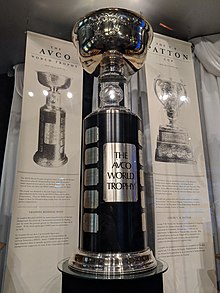
Back Avco World Trophy Czech Avco World Trophy German Avco Cup Finnish Trophée mondial Avco French Avco World Trophy Galician Avco World Trophy Italian Avco World Trophy Swedish
 | |
| Sport | Ice hockey |
|---|---|
| Competition | World Hockey Association |
| Awarded for | Playoff championship of the WHA |
| History | |
| First award | 1973 |
| Editions | 7 |
| Final award | 1979 |
| First winner | New England Whalers |
| Most wins | Winnipeg Jets (3) |
| Most recent | Winnipeg Jets |
The Avco World Trophy, also known as the Avco Cup, is the playoff championship trophy of the defunct World Hockey Association, which operated from 1972 until 1979. The trophy's naming rights were sold to the former Avco Corporation (a name originally derived from "Aviation Company"), a defense contractor who bought the rights to advertise their consumer finance division. The trophy was mocked by some for its corporate sponsorship and never developed anything approaching the significance and sentiment of the Stanley Cup, its National Hockey League rival. Still, the cup's design was often seen as creative in that it involved a freely-floating etched crystal globe embedded in the "stem" of the cup. The cup was designed by Frank Bonnerkopf of Boise, Idaho.[citation needed]
The trophy was donated to the new league in 1972 along with approximately $500,000 by the Avco Financial Services Corporation, and became the first major sports league championship trophy to bear the name of a private corporation. Three Avco trophies exist; besides the one that is on display at the Hockey Hall of Fame, the others are in Winnipeg at the Manitoba Sports Hall of Fame and Museum, and in the Nova Scotia Sports Hall of Fame in Halifax. The trophy was retired after the WHA ceased operations in 1979.[1] Led by Bobby Hull, the Winnipeg Jets claimed the trophy on three occasions, including the final league championship against Wayne Gretzky and the Edmonton Oilers. Gordie Howe and the Houston Aeros vied for the trophy three times, winning twice.
The Avco Trophy in fact may have been most famous, or perhaps infamous, in its absence. When the New England Whalers won the league's inaugural championship in 1973 the trophy had not yet been completed, and the Whalers were forced to skate their divisional championship trophy around the ice surface.[2]
- ^ "Avco World Trophy". Hockey Hall of Fame. Archived from the original on 2011-05-17. Retrieved 2011-01-03.
- ^ "The Curious Case of the WHA and Its Avco World Trophy". The Hockey Writers. 4 June 2013. Retrieved 22 November 2019.
